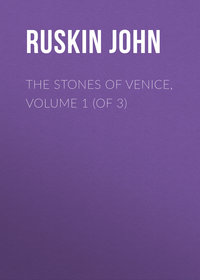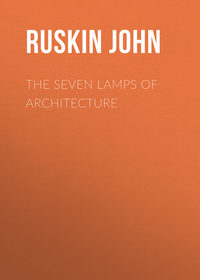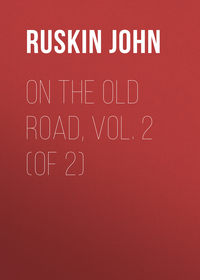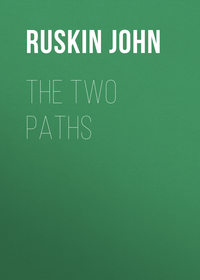 полная версия
полная версияLove's Meinie: Three Lectures on Greek and English Birds
84. The balance of this kind of bird on its legs is a very important part of its—diagnosis; (we must have a fine word now and then!) Its action on the wing, is mere flutter or flirt, in and out of the hedge, or over it; but its manner of perch, or literally 'bien-séance,' is admirable matter of interest. So also in the birds which are on the water what these are on land; picking up anything anywhere; lazy and fortunate, mostly, themselves; fat, floating, daintiest darlings;—their balance on the water, also, and under it, in 'ducking,' a most essential part of their business and being.
85. Then, directly opposed to these, in both kinds, you have the birds which must fast long, and fly far, and watch or fight for their food. Not stomachic in profile; far from cheerful in disposition; more or less lonely in habit; or, if gregarious, out of the way of men. The balance of these on the wing, is no less essential a part of their picturing, than that of the buntings, robins, and ducks on the foot, or breast: and therefore, especially the position of the head in flying.
86. Accordingly, for complete ornithology, every bird must be drawn, as every flower for good botany, both in profile, and looking down upon it: but for the perchers, the standing profile is the most essential; and for the falcons and gulls, the flying plan,—the outline of the bird, as it would be seen looking down on it, when its wings were full-spread.
Then, in connection with these general outlines, we want systematic plan and profile of the foot and head; but since we can't have everything at once, let us say the plan of the foot, and profile of the head, quite accurately given; and for every bird consistently, and to scale.
Profile and plan in outline; then, at least the head in light and shade, from life, so as to give the expression of the eye. Fallacious, this latter, often, as an indication of character; but deeply significant of habit and power: thus the projecting, full, bead, which enables the smaller birds to see the smallest insect or grain with good in it, gives them much of their bright and often arch expression; while the flattened iris under the beetling brow of the falcons,—projecting, not in frown, but as roof, to shade the eye from interfering skylight,—gives them their apparently threatening and ominous gaze; the iris itself often wide and pale, showing as a lurid saturnine ring under the shadow of the brow plumes.
87. I speak of things that are to be: very assuredly they will be done, some day—not far off, by painters educated as gentlemen, in the strictest sense—working for love and truth, and not for lust and gold. Much has already been done by good and earnest draughtsmen, who yet had not received the higher painter's education, which would have enabled them to see the bird in the greater lights and laws of its form. It is only here and there, by Dürer, Holbein, Carpaccio, or other such men, that we get a living bird rightly drawn;18 but we may be greatly thankful for the unspared labor, and attentive skill, with which many illustrations of ornithology have been produced within the last seventy or eighty years. Far beyond rivalship among them, stands Le Vaillant's monograph, or dualgraph, on the Birds of Paradise, and Jays: its plates, exquisitely engraved, and colored with unwearying care by hand, are insuperable in plume-texture, hue, and action,—spoiled in effect, unhappily, by the vulgar boughs for sustentation. Next, ranks the recently issued history of the birds of Lombardy; the lithographs by Herr Oscar Dressler, superb, but the coloring (chromo-lithotint) poor: and then, the self-taught, but in some qualities greatly to be respected, art of Mr. Gould. Of which, I would fain have spoken with gratitude and admiration in his lifetime; had not I known, that the qualified expressions necessary for true estimate of his published plates, would have caused him more pain, than any general praise could have counteracted or soothed. Without special criticism, and rejoicing in all the pleasure which any of my young pupils may take in his drawing,—only guarding them, once for all, against the error of supposing it exemplary as art,—I use his plates henceforward for general reference; finding also that, following Mr. Gould's practical and natural arrangement, I can at once throw together in groups, easily comprehensible by British children, all they are ever likely to see of British or Britain-visitant birds: which I find fall, with frank casting, into these following divisions, not in any important matters varying from the usual ones, and therefore less offensive, I hope, to the normal zoologist than my heresies in botany; while yet they enable me to make what I have to say about our native birds more simply presentable to young minds.19
88. 1. The Hawks come first, of course, massed under the single Latin term 'Falco,' and next them,
2. The Owls second, also of course,—unmistakable, these two tribes, in all types of form, and ways of living.
3. The Swallows I put next these, being connected with the owls by the Goatsucker, and with the falcons by their flight.
4. The Pies next, whose name has a curious double meaning, derived partly from the notion of their being painted or speckled birds; and partly from their being, beyond all others, pecking, or pickax-beaked, birds. They include, therefore, the Crows, Jays, and Woodpeckers; historically and practically a most important order of creatures to man. Next which, I take the great company of the smaller birds of the dry land, under these following more arbitrary heads.
5. The Songsters. The Thrush, Lark, Blackbird, and Nightingale, and one or two choristers more. These are connected with the pheasants in their speckledness, and with the pies in pecking; while the nightingale leads down to the smaller groups of familiar birds.
6. The Robins, going on into the minor warblers, and the Wrens; the essential character of a Robin being that it should have some front red in its dress somewhere; and the Cross-bills being included in the class, partly because they have red in their dress, and partly because I don't know where else to put them.
7. The Creepers and Tits—separated chiefly on the ground of their minuteness, and subtle little tricks and graces of movement.
8. The Sparrows, going on into Buntings and Finches.
9. The Pheasants (substituting this specific name for that of Scratchers).
10. The Herons; for the most part wading and fishing creatures, but leading up to the Stork, and including any long-legged birds that run well, such as the Plovers.
11. The Dabchicks—the subject of our present chapter.
12. The Swans and Geese.
13. The Ducks.
14. The Gulls.
Of these, I take the Dabchicks first, for three sufficient reasons;—that they give us least trouble,—that they best show what I mean by broad principles of grouping,—and that they are the effective clasp, if not center, of all the series; since they are the true link between land and water birds. We will look at one or two of their leading examples, before saying more of their position in bird-society. I shall give for the heading of each article, the name which I propose for the bird in English children's schools—Dame-schools if possible; a perfectly simple Latin one, and a familiar English one. The varieties of existing nomenclature will be given in the Appendix, so far as I think them necessary to be known or remembered.
IMERULA FONTIUM. TORRENT-OUZEL89. There are very few good popular words which do not unite two or more ideas, being founded on one, and catching up others as they go along. Thus I find 'dabchick' to be a corruption of 'dip-chick,' meaning birds that only dip, and do not dive, or even duck, for any length of time: but in its broader and customary use it takes up the idea of dabbling; and, as a class-name, stands for 'dabbling-chick,' meaning a bird of small size, that neither wades, nor dives, nor runs, nor swims, nor flies, in a consistent manner; but humorously dabbles, or dips, or flutters, or trips, or plashes, or paddles, and is always doing all manner of odd and delightful things: being also very good-humored, and in consequence, though graceful, inclined to plumpness;20 and though it never waddles, sometimes, for a minute or two, 'toddles,' and now and then looks more like a ball than a bird. For the most part, being clever, they are also brave, and would be as tame as any other chickens, if we would let them. They are mostly shore birds, living at the edge of irregularly broken water, either streams or sea; and the representative of the whole group with which we will begin is the mysterious little water-ouzel, or 'oiselle,' properly the water-blackbird,—Buffon's 'merle d'eau'—for ouzel is the classic and poetic word for the blackbird, or ouzel-cock, "so black of hue," in 'Midsummer Night's Dream.' Johnson gives it from the Saxon 'osle'; but in Chaucer it must be understood simply as the feminine of oiseau. The bird in question might, however, be more properly called, as Bewick calls it, 'water pyot,' or water magpie, for only its back and wings are black,—its head brown, and breast snow white.
90. And now I must, once for all, get over a difficulty in the description of birds' costume. I can always describe the neck-feathers, as such, when birds have any neck to speak of; but when, as the majority of dabchicks, they have not any,—instead of talking of 'throat-feathers' and 'stomach-feathers,' which both seem to me rather ugly words, I shall call the breast feathers the 'chemisette,' and all below them the 'bodice.'
I am now able, without incivility, to distinguish the two families of Water-ouzel. Both have white chemisettes, but the common water-ouzel (Cinclus aquaticus of Gould) has a white bodice, and the other a black one, the bird being called therefore, in ugly Greek, 'Melanogaster,' 'black-stomached.' The black bodice is Norwegian fashion—the white, English; and I find that in Switzerland there is an intermediate Robin-ouzel, with a red bodice: but the ornithologists are at variance as to his 'specific' existence. The chemisette is always white.
91. However dressed, and wherever born, the Ouzel is essentially a mountain-torrent bird, and, Bewick says, may be seen perched on a stone in the midst of a stream, in a continual dipping motion, or short curtsey often repeated, while it is watching for its food, which consists of small fishes and insects,—water insects, that is to say, caught mostly at the bottom; many-legged and shrimpy things, according to Gould's plate. The popular tradition that it can walk under the water has been denied by scientific people; but there is no doubt whatever of the fact,—see the authentic evidence of it in the delightful little monograph of the bird published by the Carlisle Naturalist's Society; but how the thing is done nobody but the ouzel knows. Its strong little feet, indeed, have plenty of grip in them, but cannot lay hold of smooth stones, and Mr. Gould himself does not solve the problem. "Some assert that it is done by clinging to the pebbles with its strong claws; others, by considerable exertion and a rapid movement of the wings. Its silky plumage is impervious to wet; and hence when the bird returns to the surface, the pearly drops which roll off into the stream are the only evidence of its recent submersion. It is, indeed, very interesting to observe this pretty bird walk down a stone, quietly descend into the water, rise again perhaps at a distance of several yards down the stream, and 'fly'21 back to the place it had just left, to perform the same maneuver the next minute, the silence of the interval broken by its cheerful warbling song."
92. In which, you see, we have the reason for its being called 'water-blackbird,' being, I think, the only one of the dabchicks that really sings. Some of the others, (sand-pipers) pipe; and others, the stints, say 'stint' in a charming manner; but none of them sing except the oiselle. Very singularly, the black-bodiced one seems to like living near manufactories. "The specimen in the Norwich Museum," says Mr. Gould, "is the one mentioned by Mr. Lubbock, in 1845, as 'lately' shot at Hellesdon Mills; and two others are stated by the same author to have been seen at different times by trustworthy observers at Marlingford and Saxthorpe. Of more recent occurrence I may mention a male in my own collection, which was brought to me in the flesh, having been shot in November, 1855, whilst hovering over the river between the foundry bridge and the ferry. It is not a little singular that a bird so accustomed to the clear running streams of the north, and the quiet haunts of the 'silent angler,' should be found, as in this case, almost within the walls of the city, sporting over a river turbid and discolored from the neighboring factories, and with the busy noise of traffic on every side. About the same time that this bird appeared near the city, three others were observed on more than one occasion on the Earlham river, by Mr. Fountaine, of Easton, who is well acquainted with our British birds; but these suddenly disappeared, and were not seen again."
And all will disappear, and never be seen again, but in skeleton, ill-covered with camphorated rags of skin, under the present scientific dispensation; unless some kind-hearted northern squire will let them have the run and the dip of his brooks; and teach the village children to let them alone if they like to wade down to the village.
I am sixty-two, and have passed as much time out of those years by torrent sides as most people. But I have never seen a water-ouzel alive.
IIALLEGRETTA NYMPHÆA. LILY-OUZEL93. We have got so far, by help of our first example, in the etymology of our entire class, as to rest in the easily memorable root 'dab,' short for dabble, as the foundation of comprehensive nomenclature. But the earlier (if not Aryan!) root 'dip,' must be taken good heed to, also, because, as we further study the customs of aquatic chickens, we shall find that they really mass themselves under the three great heads of 'Duckers,' birds that duck their heads only, and stick up their tails in the air;—'Dippers,' birds that take real dips under, but not far down, in shallow water mostly, for things at the bottom, or else to get out of harm's way, staying down about as long as we could ourselves, if we were used to it;—and 'Divers,' who plunge like stones when they choose,—can go nobody knows how deep in the deep sea,—and swim under the water just as comfortably as upon it, and as fast, if not faster.
But although this is clearly the practical and poetical division, we can't make it a scientific one; for the dippers and dabblers are so like each other that we must take them together; and so also the duckers and divers are inseparable in some of their forms: so that, for convenience of classing, we must keep to the still more general rank I have given—dabchick, duck, and gull,—the last being essentially the aerial sea-bird, which lives on the wing.
94. But there is yet one more 'mode of motion' to be thought of, in the class we are now examining. Several of them ought really to be described, not as dipchicks, but as trip-chicks; being, as far as I can make out, little in the habit of going under water; but much in the habit of walking or tripping daintily over it, on such raft or float as they may find constructed for them by water-lily or other buoyant leaves. Of these "come and trip it as you come" chicks,—(my emendation of Milton is surely more reasonable than the emendations of commentators as a body, for we do not, any of us, like to see our mistresses "trip it as they go")—there are, I find, pictured by Mr. Gould, three 'species,' called by him, Porzana Minuta, Olivaceous Crake; Porzana Pygmæa, Baillon's Crake; and Porzana Maruetta, Spotted Crake.
Now, in the first place, I find 'Porzana' to be indeed Italian for 'water-hen,' but I can't find its derivation; and in the second place, these little birds are neither water-hens nor moor-hens, nor water-cocks nor moor-cocks; neither can I find, either in Gould, Yarrell, or Bewick, the slightest notice of their voices!—though it is only in implied depreciation of their quality, that we have any business to call them 'Crakes,' 'Croaks,' or 'Creaks.' In the third place, 'Olivaceous' is not a translation of 'Minuta,' nor 'Baillon's' of 'Pygmæa,' nor 'spotted' of 'Maruetta'; which last is another of the words that mean nothing in any language that I know of, though the French have adopted it as 'Marouette.' And in the fourth place, I can't make out any difference, either in text or picture, between Mr. Baillon's Crake, and the 'minute' one, except that the minute one is the bigger, and has fewer white marks in the center of the back.
95. For our purposes, therefore, I mean to call all the three varieties neither Crake nor Porzan, but 'Allegretta,' which will at once remind us of their motion; the larger one, nine inches long, I find called always Spotted Crake, so that shall be 'Allegretta Maculata,' Spotty Allegret; and the two little ones shall be, one, the Tiny Allegret, and the other the Starry Allegret (Allegretta Minuta, and Allegretta Stellaris); all the three varieties being generally thought of by the plain English name I have given at the head of this section, 'Lily-Ouzel' (see, in § 7, page 5, the explanation of my system of dual epithet, and its limitations. I note, briefly, what may be properly considered distinctive in the three kinds.)
II.AALLEGRETTA NYMPHÆA, MACULATA. SPOTTED ALLEGRET96. Water-Crake or 'Skitty' of Bewick,—French, 'Poule d'eau Marouette,' (we may perhaps take Marouette as euphonious for Maculata, but I wish I knew what it meant);—though so light of foot, flies heavily; and, when compelled to take wing, merely passes over the tops of the reeds to some place of security a short distance off. (Gould.) The body is "in all these Rails compressed" (Yarrell,—he means laterally thin), which enables them to make their way through dense herbage with facility. I can't find anything clear about its country, except that it 'occasionally visits' Sweden in summer, and Smyrna in winter, and that it has been found in Corfu, Sicily, Crete,—Whittlesea Mere,—and Yarley Fen;—in marshes always, wherever it is; (nothing said of its behavior on ice,) and not generally found farther north than Cumberland. Its food is rather nasty—water-slugs and the like,—but it is itself as fat as an ortolan, "almost melts in the hand." (Gould.) Its own color, brown spotted with white; "the spots on the wing coverts surrounded with black, which gives them a studded or pearly appearance." (Bewick,—he means by 'pearly,' rounded or projecting.) Hence my specific epithet. Its young are of the liveliest black, "little balls of black glistening down," beautifully put by Mr. Gould among the white water Crowfoot (Ranunculus Aquatilis), looking like little ducklings in mourning. "Its nest is made of rushes and other buoyant materials matted together, so as to float on, and rise or fall with, the ebbing or flowing of the water like a boat; and to prevent its being carried away, it is moored or fastened to a reed." (Bewick.)
II.BALLEGRETTA NYMPHÆA, STELLARIS. STARRY ALLEGRET97. Called 'Stellaris' by Temminck.—I do not find why, but it is by much the brightest in color of the three, and may be thought of as the star of them. Gould says it is the least, also, and calls it the 'Pigmy'; but we can't keep that name without confusing it with the 'Minuta.' 'Baillon's Crake' seems the most commonly accepted title,—as the worst possible. Both this, and the more quietly toned Tiny, in Mr. Gould's delightful plates of them, have softly brown backs, exquisitely ermined by black markings at the root of each feather, following into series of small waves, like little breakers on sand. They have lovely gray chemisettes, striped gray bodices, and green bills and feet; a little orange stain at the root of the green bill, and the bright red iris of the eye have wonderful effect in warming the color of the whole bird: and with beautiful fancy Mr. Gould has put the Stellaris among yellow water-lilies to set off its gray; and a yellow butterfly with blue and red spots, and black-speckled wings (Papilio Machaon), to harmonize both. It is just as if the flower were gradually turning into the bird. Examples of the Starry Allegret have been 'obtained'—in the British Islands. It is said to be numerous, unobtained, in India, China, Japan, Persia, Greece, North Africa, Italy, and France. I have never heard of anybody's seeing it, however.
II.CALLEGRETTA NYMPHÆA, MINUTA. TINY ALLEGRET98. 'Tiny Allegret,'—Yarrell's 'Little Crake,' (but see names in Appendix). It is a little more rosy than 'Stellaris' in the gray of its neck, passing into brown; and Mr. Gould has put it with a pink water plant, which harmonizes with it to the bird's advantage; while the tiny creature stands on the bent leaf of a reed, and scarcely bends it more! "It runs with rapidity over broken reeds, and moves gracefully, raising and displaying its tail at every step." It has so very small a tail to display, however, that I should hardly think the display was worth while. "It is very cunning, and especially noticeable for the subtlety with which it wearies the dog of the sportsman by executing a thousand evolutions with surprising celerity; whence comes the trivial name of 'kill-dog' bestowed upon it in some localities. Pursued to extremity, it casts itself into the water, swims with ease, and dives at the moment its enemy is about to seize it; or it conceals itself in a tuft of reeds or a bush, and by this means often escapes with impunity. It loves to breed among the reeds, and in long and thick grass, frequently in small companies of its own species, or of the Stellaris. The female lays her eggs on an inartificially constructed platform of decayed leaves or stalks of marsh plants, slightly elevated above the water." How elevated, I cannot find proper account,—that is to say, whether it is hung to the stems of growing reeds, or built on hillocks of soil, but the bird is always liable to have its nest overflowed by floods. The full-grown bird is dressed in an exquisite perfection of barred bodice, spotted chemisette, and waved feathers edged with gray on the back.
99. The reader will please recollect these three Allegrets as the second group of the dab- or dabble-chicks; and, while the water-ouzel is a mountain and torrent bird, these inhabit exclusively flat lands and calm water, belonging properly to temperate, inclining to warm, climates, and able to gladden for us—as their name now given implies—many scenes and places otherwise little enlivened; and to make the very gnats of them profitable to us, were we wise enough. Dainty and delightful creatures in all their ways,—voice only dubitable, but I hope not a shriek or a squeak;—and there seems to be no reason whatever why half our fen lands should not be turned into beds of white water lilies and golden ducks, with jetty ducklings, to the great comfort of English souls.22
IIITREPIDA STAGNARUM. LITTLE GREBE100. The two birds—Torrent-ouzel, and Lily-ouzel,—which we have been just describing, agree, you will observe, in delicate and singular use of their feet in the water; the torrent-ouzel holding itself mysteriously at the bottom; and the lily-ouzel, less mysteriously, but as skillfully, on the top (for I forgot to note, respecting this raft-walking, that the bird, however light, must be always careful not to tread on the edges of leaves, but in the middle, or, rather, as nearly as may be where they are set on the stalk; it would go in at once if it trod on the edges). But both the birds have the foot which is really characteristic of land, not water-birds; and especially of those land species that run well. Of the real action of the toes, either in running, or hopping, nothing is told us by the anatomists—(compare lecture on Robin, § 26); but I hope before long to get at some of the facts respecting the greater flexibility of the gripping and climbing feet, and elasticity of running ones; and to draw up something like a properly graduated scale of the length of the toes in proportion to that of the body.
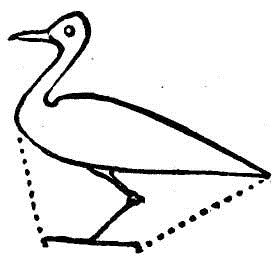
Fig. 12.
And, for one question, relative to this—the balance of a bird standing, not gripping—is to be thought of. Taking a typical profile of bird-form in its abstract, with beak, belly, and foot, horizontal (Fig. 12), the security of the standing, (supposing atomic weight equal through the bird's body, and the will, in the ankle, of iron,) is the same as of an inverted cone, between the dotted lines from the extremities of the foot to those of the body; and, of course, with a little grip of the foot or hind claw, the bird can be safe in almost any position it likes. Nevertheless, when the feet are as small in proportion as the Torrent-ouzel's, I greatly doubt the possibility of such a balance as Bewick has given it (Fig. 13 a). Gould's of the black-bodiced Ouzel (Fig. 13 b) is, I imagine, right. Bewick was infallible in plume texture, and expression either of the features of animals, or of any action that had meaning in it; but he was singularly careless of indifferent points in geometry or perspective; and even loses character in his water-birds, by making them always swim on the top of the water.




